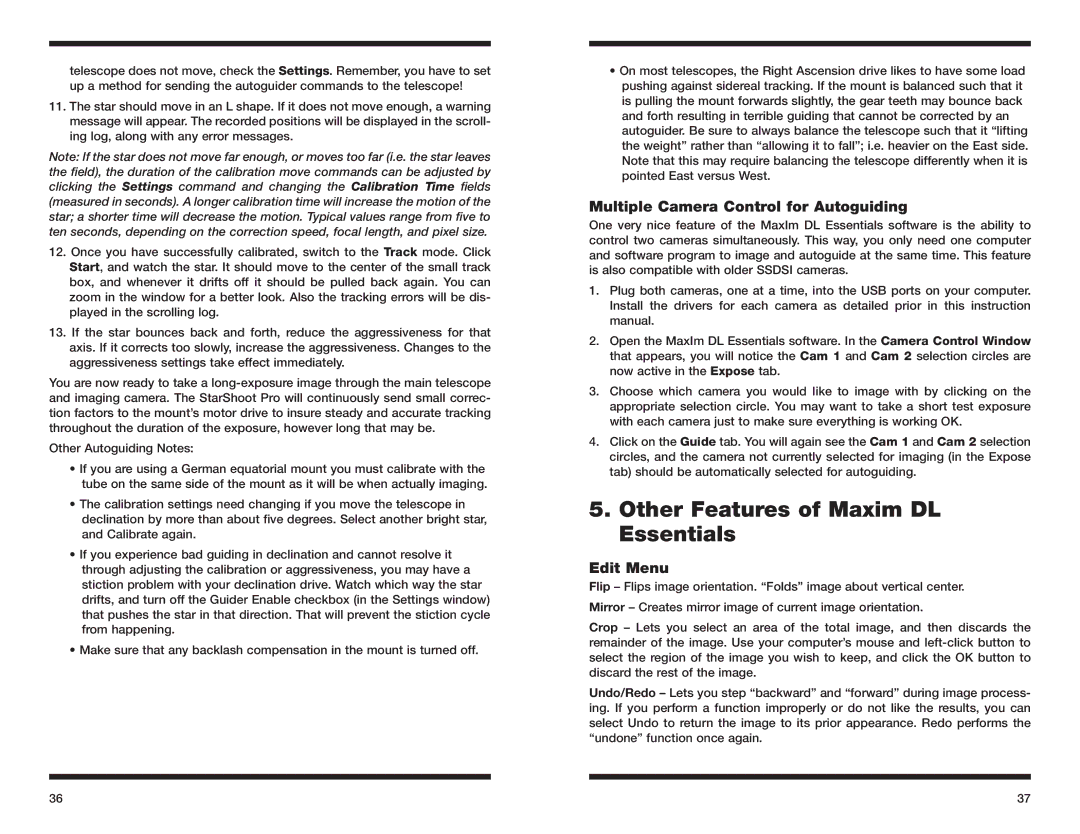
telescope does not move, check the Settings. Remember, you have to set up a method for sending the autoguider commands to the telescope!
11.The star should move in an L shape. If it does not move enough, a warning message will appear. The recorded positions will be displayed in the scroll- ing log, along with any error messages.
Note: If the star does not move far enough, or moves too far (i.e. the star leaves the field), the duration of the calibration move commands can be adjusted by clicking the Settings command and changing the Calibration Time fields (measured in seconds). A longer calibration time will increase the motion of the star; a shorter time will decrease the motion. Typical values range from five to ten seconds, depending on the correction speed, focal length, and pixel size.
12.Once you have successfully calibrated, switch to the Track mode. Click Start, and watch the star. It should move to the center of the small track box, and whenever it drifts off it should be pulled back again. You can zoom in the window for a better look. Also the tracking errors will be dis- played in the scrolling log.
13.If the star bounces back and forth, reduce the aggressiveness for that axis. If it corrects too slowly, increase the aggressiveness. Changes to the aggressiveness settings take effect immediately.
You are now ready to take a
Other Autoguiding Notes:
•If you are using a German equatorial mount you must calibrate with the tube on the same side of the mount as it will be when actually imaging.
•The calibration settings need changing if you move the telescope in declination by more than about five degrees. Select another bright star, and Calibrate again.
•If you experience bad guiding in declination and cannot resolve it through adjusting the calibration or aggressiveness, you may have a stiction problem with your declination drive. Watch which way the star drifts, and turn off the Guider Enable checkbox (in the Settings window) that pushes the star in that direction. That will prevent the stiction cycle from happening.
•Make sure that any backlash compensation in the mount is turned off.
•On most telescopes, the Right Ascension drive likes to have some load pushing against sidereal tracking. If the mount is balanced such that it is pulling the mount forwards slightly, the gear teeth may bounce back and forth resulting in terrible guiding that cannot be corrected by an autoguider. Be sure to always balance the telescope such that it “lifting the weight” rather than “allowing it to fall”; i.e. heavier on the East side. Note that this may require balancing the telescope differently when it is pointed East versus West.
Multiple Camera Control for Autoguiding
One very nice feature of the MaxIm DL Essentials software is the ability to control two cameras simultaneously. This way, you only need one computer and software program to image and autoguide at the same time. This feature is also compatible with older SSDSI cameras.
1.Plug both cameras, one at a time, into the USB ports on your computer. Install the drivers for each camera as detailed prior in this instruction manual.
2.Open the MaxIm DL Essentials software. In the Camera Control Window that appears, you will notice the Cam 1 and Cam 2 selection circles are now active in the Expose tab.
3.Choose which camera you would like to image with by clicking on the appropriate selection circle. You may want to take a short test exposure with each camera just to make sure everything is working OK.
4.Click on the Guide tab. You will again see the Cam 1 and Cam 2 selection circles, and the camera not currently selected for imaging (in the Expose tab) should be automatically selected for autoguiding.
5.Other Features of Maxim DL
Essentials
Edit Menu
Flip – Flips image orientation. “Folds” image about vertical center. Mirror – Creates mirror image of current image orientation.
Crop – Lets you select an area of the total image, and then discards the remainder of the image. Use your computer’s mouse and
Undo/Redo – Lets you step “backward” and “forward” during image process- ing. If you perform a function improperly or do not like the results, you can select Undo to return the image to its prior appearance. Redo performs the “undone” function once again.
36 | 37 |
